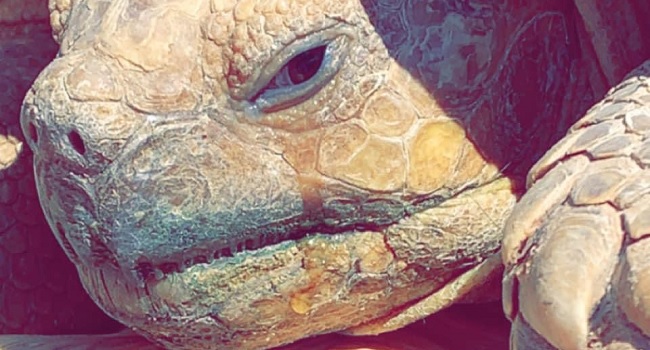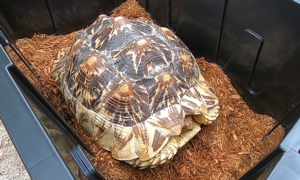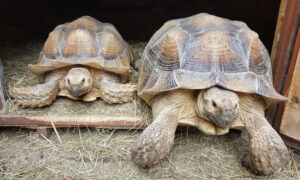When you have a pet, you may wonder if it’s hearing or eyesight is similar to yours. Will your sulcata eat better out of an orange food dish because it’s bright or will he really care regardless of the color? Well, you’re not alone and there have been studies on tortoise eyesight and whether tortoises, like sulcatas, see colors.
Sulcata Tortoise Eye Structure
Like most reptiles, sulcata tortoises have simple eyes when compared to mammals and birds. Their eyes are adapted to their native habitat, which is the semi-arid regions of Africa. The size and placement of their eyes allow sulcatas to focus on and detect movement.
The very simplistic structure of a tortoise eye include the pupil, retina and cones. There’s a round pupil that lets light in. A retina converts light and signals to the optic nerve. And there are cones in the eye that distinguish color.
Color Receptors in Tortoise Eyes
Cones are receptors in the eye that allow you to see color. People have three types of cones that allow us to see a broader spectrum of colors, whereas dogs only have two types of cones in their eyes, limiting their color range.
Studies show that tortoises have color receptors in their eyes, but not as many as people, which means they see colors, but it is limited.
Does UV Light Play a Role in Colors?
Sulcata tortoises have a sensitivity to ultraviolet (UV) light. They can see in the UV spectrum, which is actually invisible to the human eye. This ability is significant in their natural habitat where UV light plays a more crucial role in ecological processes.
Essentially UV light has a shorter wavelength than regular visible light, and many objects will retain a UV pigment. For example, flowers will accumulate UV pigment in their petals, forming patterns that bugs and other animals can see.
UV vision helps sulcata tortoises see and identify mates for breeding, finding food and navigating terrain.
Studies Whether Sulcata Tortoises See in Color
There are studies that have tried to monitor how sulcata tortoises behaved to different environmental conditions in order to determine their visual abilities. For example, researchers have observed changes in their behavior in response to colored objects. The results were inconclusive as it’s unsure whether color had an effect on the tortoise’s behavior.
Brightness, contrast or overall familiarity can play a role in why the sulcata tortoise reacts one way or the other to an object. For example, will your tortoise pick a red flower because it’s red or will he choose the blue flower? Is the red flower his favorite because that’s what you normally offer your sulcata as a treat?
Austrian researchers used Greek tortoises and electroretinogram recordings to measure their retinal responses to different wavelengths of light. The Greek tortoises were able to distinguish between longer wavelength colors in the green and red parts of the spectrum. The researchers determined it’s likely the tortoises are not colorblind but have a more dichromatic vision. The study was published in 2014, the University of Vienna, Austria published a study about tortoise eyesight in the journal “Journal of Experimental Biology.”
Essentially, whether sulcata tortoises see in color or not is a more complicated question than a yes or no answer can provide. And, in the end, it’s thought that sulcatas can see some shades but cannot see the broad spectrum of color that humans can.





